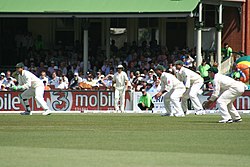This article relies largely or entirely on a single source. (November 2014) |


In cricket, a slip fielder (collectively, a slip cordon or the slips) is placed behind the batsman on the off side of the field. They are placed with the aim of catching an edged ball which is beyond the wicket-keeper's reach. Many teams employ two or three slips (numbered from the slip fielder closest to the wicket-keeper: first slip, second slip, etc.). A floating slip is sometimes employed, usually in limited over games, who patrols an area in the slip cordon that would ordinarily be occupied by more than one fielder. The slip cordon's distance from the batsman increases with the pace of the bowler; generally they will be marginally further away from the batsman than the wicket-keeper is. Because of the resulting geometry, spin bowlers generally have fewer slips in the cordon than a fast bowler would in an equivalent game situation. As fielding in the slips requires quick reflexes and sure hands, usually the most adept catchers in the team will make up the slip cordon. Most slip fielders are top order batsmen. Specialist slip fielders are sometimes called "slippers".[1]
The term slips is also used to refer to the area of the field where the slip cordon stands, or nth slip used specifically to refer to one slip fielder's position—e.g., a ball may be described as being edged through third slip if it goes where a third slip would otherwise have been.
- ^ Lynch, Steven (19 January 2004). "The worst bowling average, and mystery injuries". ESPNcricinfo. Archived from the original on 1 July 2018. Retrieved 1 July 2018.